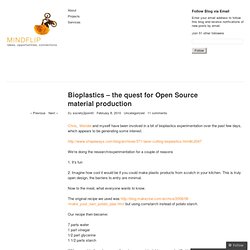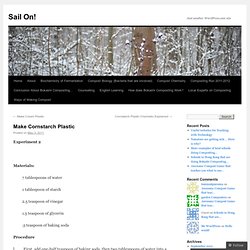

Filabot. Filastruder: A robust, inexpensive filament extruder. by Tim Elmore. We've successfully shipped our Kickstarter kits, and we're ready to take orders through our website - ****************************WAITLIST OPEN:Many of you have asked for more kits.

We are pretty much at capacity, with orders into September, but have opened a waitlist to notify you as soon as we're ready to ship again. Send an email to filastruder@gmail.com to reserve your spot. We will not take further orders until the Kickstarter rewards have shipped. Thanks! Filastruder. This is what makes the Filastruder do what it does.

Using the power of science, this little motor turns the whole operation into a filament-making machine. This motor produces filament almost twice as fast as the motor included with the Kickstarter kits, and is a direct drop-in replacement. 3D Printing Filament - Filabot. Multi-Products Company. Recycling 3D printer plastic. Personal filament produce machine with mini shredder. LYMAN FILAMENT EXTRUDER V3 VIDEO. At-home filament maker for 3D printers. Plastic Shredder. Filabot Personal Filament Maker for 3D Printers. Bioplastic - the plastic wrap that's good enough to eat. Video transcript PLEASE NOTE: THIS EDIT CONTAINS CONVERTED 4:3 MATERIAL According to the U.S.

Environmental Protection Agency hundreds of millions of tons-worth of plastic bags are discarded every year. BIO-PLASTIC HANKBOOK 2011. Polylactic acid. Poly(lactic acid) or polylactide (PLA) is a thermoplastic aliphatic polyester derived from renewable resources, such as corn starch (in the United States), tapioca roots, chips or starch (mostly in Asia), or sugarcane (in the rest of the world). In 2010, PLA had the second highest consumption volume of any bioplastic of the world.[3] The name "poly(lactic acid)" does not comply with IUPAC standard nomenclature, and is potentially ambiguous or confusing, because PLA is not a polyacid (polyelectrolyte), but rather a polyester.[4] Production[edit] There are several industrial routes to usable (i.e. high molecular weight) PLA. Make your own bioplastic. Bioplastics – the quest for Open Source material production « Mindflip. Chris, Mendel and myself have been involved in a bit of bioplastics experimentation over the past few days, which appears to be generating some interest.

Plastics from Potatoes: Practical demonstration. Plastics from Potatoes: Practical demonstration. Make Cornstarch Plastic. Experiment 2 Materials: 7 tablespoons of water 1 tablespoon of starch 2.5 teaspoon of vinegar 1.5 teaspoon of glycerin .5 teaspoon of baking soda Procedure l First, add one-half teaspoon of baking soda, then two tablespoons of water into a separate, small container, then set it aside for later. l Add seven tablespoons of cold water into a pan, then about one tablespoon of starch.

Turn the burner to low heat, and then stir the mixture. Add the baking soda and water mixture, then let everything in the pan boil for 10 minutes. Get a sheet of aluminum foil so that you can carefully pour the gooey substance onto it for drying. Let the potato substance dry for one day in a sunny room, or place it into the oven for faster results. Mold or shape your newly created plastic. YouTube. How Corn Plastics Are Made, And Why We Still Aren't Thrilled. Our Discovery Channel sister site How Stuff Works has put out an interesting video on how corn plastics work.

The video is informative about how corn plastics, or PLA, is produced. But it got us thinking about other issues with PLA that weren't really addressed.Corn plastics are controversial for a few reasons, not the least of which are that they use a resource that is energy intensive to produce, and because they can really gum up the works of recycling centers when not sorted properly. PLA can be sorted and recycled, but it takes some energy intensive processes to do it. That means they're energy intensive, and carbon intensive, from the start all the way to the end. Also, PLA looks a whole lot like other plastics such as PET. Many manufacturers and organizations call for PLA products to be very clearly marked when used, so that they can be more easily sorted. YouTube. Making Bioplastic (PLA) From Earth to Pellet: Comparing Resource Requirements between PLA, PP, PET and EPS Products Download the .pdf here.

Temperaturas. CNBP_024548. Uso de la yuca (Manihot esculenta Crantz) y otras fuentes de almidones no convencionales en la alimentación de rumiantes. Art-4. Recipes. Bioplastic Experiment. Experiment home Objective The objective of the “Bioplastics Experiment” is to show the students the advantages and disadvantages of running a fractional factorial.

The students run a 2^k-1 fractional factorial to determine which levels of bioplastic ingredients / cooking method produce the best quality bioplastic. The students break up into four groups. Each group selects a different bioplastic; Milk plastic, Stovetop corn plastic, Microwave corn plastic and Flubber. Equipment - per group Making bioplastics requires various kitchen supplies and some perishable items. Starch%20to%20Plastics%20Lab%20-%20teachers%20notes. 3D printing materials. Polymers Luisa Pereira and Manuela Donoso collaborated on this musical instrument made of elastics and light.

On the first version they used regular elastics coated with conductive ink and on the final version opted for stretch ... In this video Becky Stern from Adafruit shows how to make a simple circuit on a transparent sheet of plastic coated with indium tin ... Heart On Your Sleeve from Scott Garner on Vimeo. Endlighten is an acrylic sheet infused with colorless light diffusing particles. While regular acrylic only diffuses light around the edges, ... light diffusing acrylic Materials 101, Polymers Shape memory polymer strips (image by Inventables) Heat Reactive Materials Heat reactive materials change state, shape and/or color when exposed to temperatures above ambient. Heat reactive polymers. Welcome to Reprap-Walmart! - Price compare 3D printers. Price compare 3D printing materials.